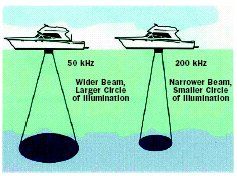Quote:
Originally Posted by lowprofile

then what does the KHZ do?  its a frequency. lower frequency will produce a wider cone and penetrate farther. higher is more dense but dissipates quicker.
 |
The transducer concentrates the sound into a beam. When a pulse of sound is transmitted from the transducer, it covers a wider area the deeper it travels. If you were to plot this on a piece of graph paper, you would find that it creates a cone shaped pattern, hence the term "cone angle." The sound is strongest along the center line or axis of the cone and gradually diminishes as you move away from the center.
In order to measure the transducer's cone angle, the power is first measured at the center or axis of the cone and then compared to the power as you move away from the center. When the power drops to half (or -3db in electronic terms), the angle from that center axis is measured. The total angle from the -3db point on one side of the axis to the -3db point on the other side of the axis is called the cone angle.
This half power point (-3db) is a standard for the electronics industry and most manufacturers measure cone angle in this way, but a few use the -10db point where the power is 1/10 of the center axis power. This obviously gives a greater angle as you are measuring a point further away from the center axis. Nothing is different in transducer performance, only the system of measurement has changed. For example, a transducer that has an 8 degree cone angle at -3db would have a 16 degree cone angle at -10db.

Lowrance offers transducers with a variety of cone angles. Wide cone angles will show you more of the underwater world, at the expense of depth capability, since it spreads the transmitter's power out. Narrow cone angle transducers won't show you as much of what's around you, but will penetrate deeper than the wide cone. The narrow cone transducer concentrates the transmitter's power into a smaller area. A bottom signal on the sonar unit's display will be wider on a wide cone angle transducer than on a narrow one because you are seeing more of the bottom. The wide cone's area is much larger than the narrow cone.
High frequency (192 - 200 kHz) transducers come in either a narrow or wide cone angle. The wide cone angle should be used for most freshwater applications and the narrow cone angle should be used for all saltwater applications. Low frequency (50 kHz) sonar transducers are typically in the 30 to 45 degree range. Although a transducer is most sensitive inside its specified cone angle, you can also see echoes outside this cone; they just aren't as strong. The effective cone angle is the area within the specified cone that you can see echoes on the display. If a fish is suspended inside the transducer's cone, but the sensitivity is not turned up high enough to see it, then you have a narrow effective cone angle. You can vary the effective cone angle of the transducer by varying the receiver's sensitivity. With low sensitivity settings, the effective cone angle is narrow, showing only targets immediately beneath the transducer and a shallow bottom. Turning the sensitivity control up increases the effective cone angle, letting you see targets farther out to the sides.